|
|
| |
|
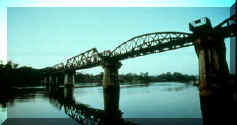
View Photo |
The real bridge near Kanchanaburi, Thailand was built over
several months in1942 by civilian slave labor and POWs as part of the
Death Railway. The bridge
was not made of bamboo, but rather steel and concrete. |
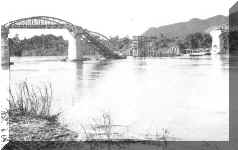
View Photo |
The Japanese used the
bridge for two years during World War II before it was destroyed. The
bridge was not blown to smithereens as Hollywood imagined, but rather was
bombed by allied warplanes in late June 1945. B-24 Liberator
Bombers dropped four 1,000 pound bombs from treetop level, destroying the
two center spans. |
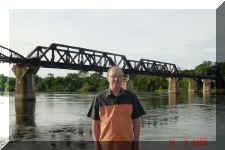
View Photo |
The Japanese rebuilt
the two center spans after the war as reparations to the Kingdom of
Thailand. The new spans were built by Yokogawa Bridge Works of
Tokyo; they are not arched as are the originals. |
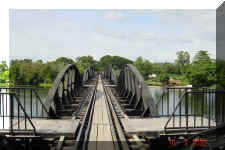
View Photo |
An estimated 13,000
POWs and 80,000 Asian laborers died of disease, sickness, and starvation at
the hands of the Japanese Army. The number of POWs forced to work on
the railway included 30,000 British; 18,000 Dutch; 13,000 Australian; and
700 Americans. The death toll included 6,540 British; 2,830 Dutch;
2,710 Australian; 220 Malay; 33 Indian; 5 New Zealand; and 356 Americans.
I first visited the bridge in 1987. I next visited the bridge
in September of '03, August of '04, March of '05 and April of '07. |

Read the Inscription |
Inscribed on a wall near the east bank of the Bridge over the River Kwai.
Click Here or on the
Picture to Read the Inscription
There are several factual
errors contained in this inscription and numerous grammatical and
punctuation errors as well. The most glaring factual error is that the
inscription makes no mention of American P.O.W.'s working or dying during
the construction of the Railroad. |
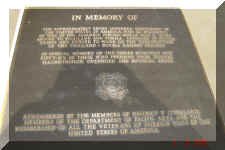
View Photo |
A memorial at the bridge site erected by VFW of America, dedicated to the
Americans who worked on the railway and to those who died. The Plaque
reads:
IN MEMORY OF
The
approximately seven hundred servicemen of
The United States Of America, who as prisoners
of war of the Japanese during World War II, were
moved to Thailand and Burma, interned in prison
camps and forced to work on the construction
of the Thailand - Burma Railway Project.
In special memory of
the three hundred and
fifty-six of these who perished from disease,
malnutrition, overwork and physical abuse.
Remembered by the
members of District V (Thailand),
members of the Department of Pacific Area and the
membership of all the Veterans of Foreign Wars of The
United States of America |
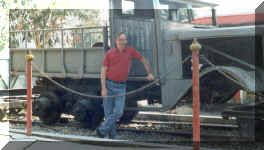
View Photo |
The Japanese converted
this truck to a railway engine. This picture was taken in
February 1987. |
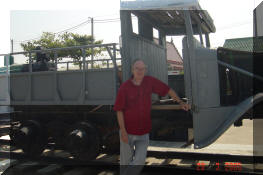
View Photo
|
Eighteen years later and
the old truck is holding up just fine other than the wood doors having
withered away. I am holding up just fine also, other than most
of my hair having withered away. |
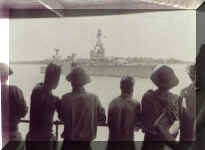
USS Houston in Darwin Harbor
View Photo
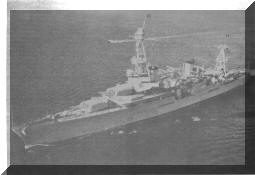
USS Houston at Sea in 1939
View Photo
|
Among the many allied POWs that suffered
the hell of the railway were survivors from HMAS PERTH and USS HOUSTON (CA 30).
The PERTH and HOUSTON, under the command
of Captain Albert Rooks, fought a large Japanese force in Sunda Strait on
28 February 1942. The two
cruisers, low on fuel and ammunition, had attacked the Java invasion
fleets and sunk several transports, including the one carrying the
Commanding General; but had in turn been overwhelmed by twelve Imperial
Navy warships. After 85
torpedoes being fired at them, both were sunk.
Of the crew of 1011 men, 386 survived and swam to the Java coast, only to be
captured by the Japanese.
That battle became known as the 'Battle Of Sunda Strait' (between Java
and Sumatra).
Houston's fate was not known by the world for almost nine months, and the
full story of her courageous fight was not fully told until after the war
when the survivors were liberated from prison camps. Captain Rooks
received posthumously the Medal of Honor for this extraordinary heroism.
Read
Captain Rooks' Medal of Honor Citation |
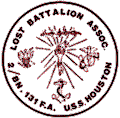
The
Lost Battalion Association is
composed of the men of the 2nd
Battalion, 131st Field Artillery and those men who swam ashore
from the Cruiser USS Houston (CA-30) when it was sunk, and who survived 42
months of "hell" as prisoners of the Japanese during World War-II
Special Thanks to
Lori Buzzo of
The
Lost Battalion Association for information about the heroes of the
2nd Battalion, 131 F.A. and the
USS Houston.
|
Another group of
allied POWs forced to endure the horrors of the Death Railroad were from 2nd Battalion, 131st
Field Artillery. That unit of the 36th Division (Texas National Guard)
had sailed from Pear Harbor just days before the Japanese surprise
attack. They were bound for the Philippines, but were diverted
to Australia, then to Java to help in the defense of that Dutch East Indies
Island of Java. When the Dutch surrendered to the Japanese in early 1942, the
534 survivors of the 2nd Battalion became POWs.
The 2nd Battalion and the survivors of the U.S.S.
Houston were not heard from again until the end of the war. The fate
of many from the
Lost Battalion, was to suffer the Hell of Japan's Death Railroad.
Read a short History of the Lost
Battalion |
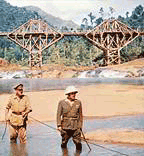 |
The 1957 Film “The
Bridge on the River Kwai” was
based on the true story of POWs in WW II forced to build the
Bangkok-Rangoon railway bridge over the Kwai River. Filmed in
Ceylon (Sri Lanka), the movie bridge was built in 8 months by 500 workers
and 35 elephants; compared to the real bridge which was built in just 6
months. The bamboo bridge was 50 feet (15.25m) above
the water and 425 feet (129.5m) long. |

View Poster |
THE BRIDGE ON THE
RIVER KWAI was the number one box-office success of 1957. It won
critical acclaim and seven Academy Awards including Best Picture. |